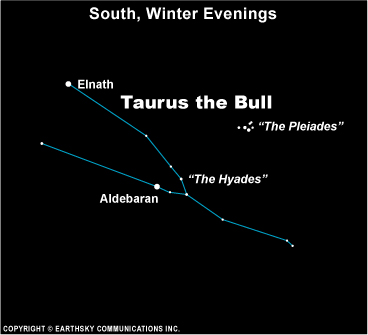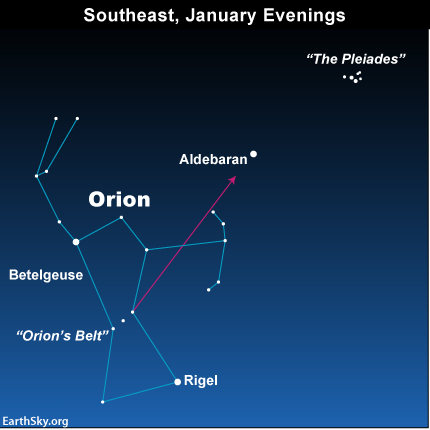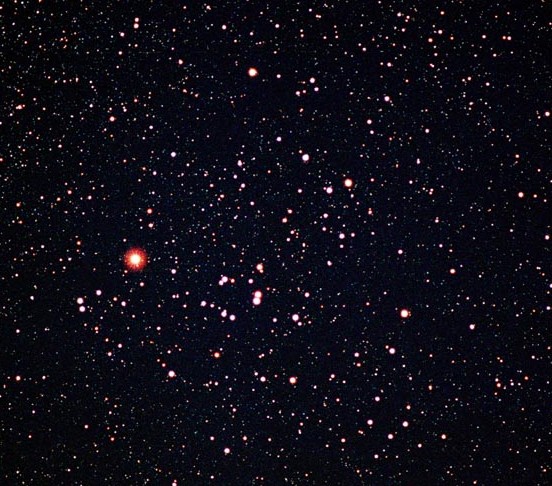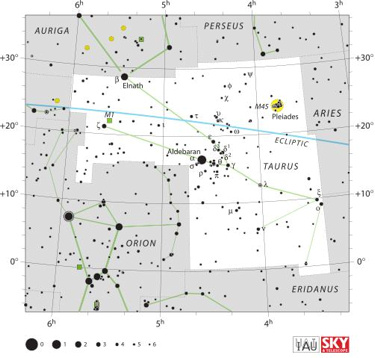
With the exception of the Ursa Major Moving Cluster, the Hyades cluster is the closest star cluster to Earth, at a distance of 150 light-years. This cluster is very easy to spot in the night sky, because it has a compact and distinctive shape of the letter V. Follow the links below to learn more about the Hyades.
How to find the Hyades star cluster.
History and mythology of the Hyades.
In 2015, Comet Lovejoy near Hyades cluster from about January 9 to 15

View larger. | This photo map shows Comet Lovejoy’s nightly position among the winter stars through January 19 as it travels across the constellation Taurus not far from the bright reddish star Aldebaran (which is part of the V-shaped Hyades, or Face of the Bull) and the tiny, misty, dipper-shaped Pleiades star cluster. Credit: Bob King. Used with permission. Read more about how to find Comet Lovejoy.

To find Comet Lovejoy, look for the V-shaped Hyades star cluster. The brightest star in the V is reddish Aldebaran. Photo taken January 11, 2015 by Annie Lewis in Madrid, Spain. Thank you, Annie! Read more about how to find Comet Lovejoy.

Hyades star cluster. Copyright 2012 Jerry Lodriguss/AstroPix.com. Used with permission. This image was the Astronomy Picture of the Day for December 24, 2012.

The Hyades star cluster can be found in the south on winter evenings and is edging toward the western half of the sky by spring. It has the shape of the letter V. The brightest star in the V in Aldebaran. The small dipper-shaped Pleiades star cluster is nearby.

Here are Orion, the bright star Aldebaran in Taurus, and the Pleiades. Notice the three stars of Orion’s “Belt,” that is, three stars in a short row. Notice that these stars point to Aldebaran.
How to find the Hyades star cluster. The Hyades cluster is easy to find by using Orion’s Belt, a compact and noticeable line of three blue-white stars in the constellation Orion the Hunter. Draw a line westward (generally toward your sunset direction) through the Belt stars, and you will come to the bright ruddy star Aldebaran, the Bull’s fiery red eye.
Aldebaran is part of the V-shape formation of stars that represents in the Bull’s face. This V of stars is the Hyades.
Although Aldebaran isn’t a true member of the Hyades star cluster, this bright star is a great guide to this cluster. In fact, Aldebaran is only about 65 light-years distant. The Hyades lies about 2.5 times farther off.
The V-shape figurine of stars (except Aldebaran) highlights the brightest of the Hyades’ few hundred stars. A dozen or more Hyades stars are visible to the unaided eye in a dark country sky, but several dozen of the cluster’s stars can be resolved through binoculars or low power in a telescope. From the northern hemisphere, the Hyades are best seen in the evening sky in winter and spring.
The constellation Taurus the Bull is home to another bright star cluster, the Pleiades. The Pleiades cluster is more distant than the Hyades at some 430 light-years away. Both the Hyades and Pleiades are easily visible to the unaided eye. Both are enhanced by viewing with binoculars.

The Hyades – like their half sister the Pleiades – were nymphs of Greek mythology. Image via Greek Mythology Link – by Carlos Parada
History and mythology of the Hyades. According to sky lore, the teary Hyades are the daughters of Atlas and Aethra, who are forever crying for their brother Hyas, who was killed by a lion or a boar. The Hyades are the half sisters to the Pleiades, the daughters of Atlas and Pleione. The gods purposely kept Atlas’ daughters – the Hyades and the Pleaides – out of reach of Orion, giving them a safe haven from his lustful pursuits.
The gods transformed Hyas into the constellation Aquarius, and the lion that killed him into the constellation Leo. The gods placed Aquarius and Leo on opposite sides of the sky for Hyas’ protection. That’s why Aquarius and Leo do not appear in the same sky together. As one constellation sets in the west, the other rises in the east – and vice versa.

A telescope reveals over 100 stars in the Hyades cluster. The bright red star here is Aldebaran. Photo via astronomycafe.net.
Hyades science. Although the Hyades and Pleaides are half sisters in mythology, science finds no close relationship in space between these two star clusters.
Astronomers find that the Pleiades are composed of hot blue-white suns in the heyday of youth, which puts the age of the cluster at about 100 million years. In contrast, the cooler red giant and white dwarf stars found in the Hyades indicate a vastly older cluster over 700 million years old.
Interestingly, astronomers suspect an actual kinship between the Hyades cluster and the Beehive star cluster in the constellation Cancer the Crab. Even though these two star clusters are separated from one another by hundreds of light-years, they are akin in age and travel in a similar direction in space. Astronomers believe these clusters might have originated from the same gaseous nebula some 700 to 800 million years ago.

The three bright stars in a row are Orion’s Belt. They point to the Hyades star cluster. Photo via Flickr user Unishot

View larger. | More detail on the starry sky around the Hyades. Notice that Orion's Belt (lower left) points to the Hyades.
Bottom line: On January evenings, look for a V-shaped pattern of stars. The Hyades star cluster represents the Face of Taurus the Bull. The cluster is easy to spot and beautiful in binoculars.


















